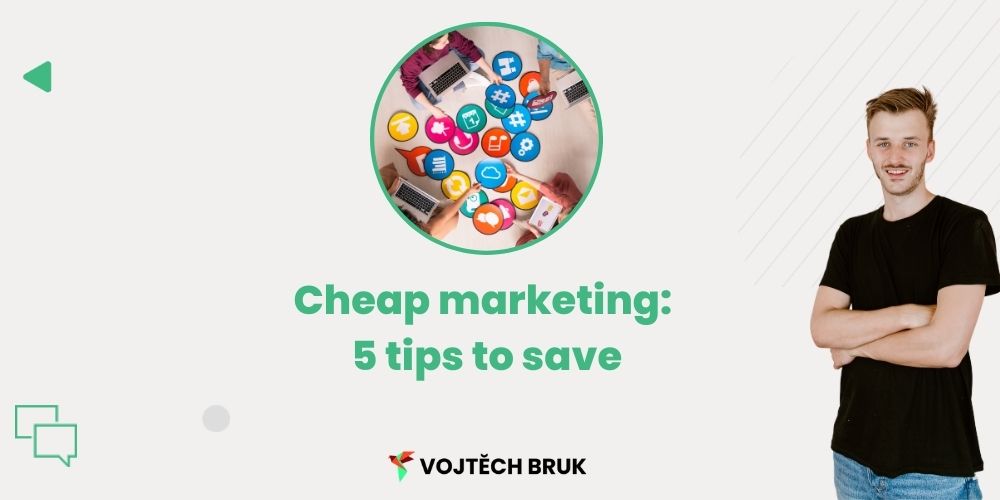Companies and individuals are currently facing a number of challenges:
- increasing costs,
- cooling demand,
- uncertain outlook…
All of this leads to the need to reduce and optimize costs.
As part of this optimization, marketing is quite possibly one of the first things you’ll want to focus on.
In this article, I’ll then look at what to think about before you get started and then present the 5 tips that I find most effective in terms of cost optimization.
Ready?
Is it a good idea to “skimp” on marketing?
No. Optimal marketing should bring in more money than it costs. And skimping on something that multiplies its own costs is logically nonsense.
However, this is often not the case. And marketing costs you more than it brings in.
At such times, it may be a good idea to optimize its price.
Below are the top 5 tips for getting started with optimization.
1. Start with an audit
First, sit down and write down all the costs you put into marketing:
- Content creation and promotion
- Social media management
- Website creation, management fees
- Advertising in the offline world
- Your SEO efforts, or SEO consultant payouts
- Paid advertising, remarketing, retargeting
And other items specific to your type of business.
Once you have written down your expenses, also write down the (at least estimated) revenue that comes from the activities.
This is by no means a simple step, but it is a sound basis for optimizing spending, and the output will also serve as a great compass for where to go next.If you have a team to help you with the audit, you can break down the performance measurement into even smaller parts (individual keywords, individual ad campaigns…).
The key is to have an idea of what is (not) working and how before you go any further.
If you’re pressed for budget, you’ll want to focus on optimizing and maximizing what works rather than embarking on new experiments. However, in order to know what you’ll miss the least, it’s crucial to conduct this initial audit.
2. Focus on fewer things properly
Once you have an idea of your current performance, get to work on making changes. One of the most effective changes is probably to reduce the number of active marketing channels you’re using.I personally have accounts on all sorts of social media, a number of forums, and have created content on a number of sites and platforms as well. However, I know that by far the most effective is writing blog posts and creating YouTube videos.
The rest is just a supplement and a distraction for now. And while I won’t be deleting the other accounts, I certainly won’t be expanding them either.
Resist instant gratification
Many marketing activities, such as SEO or article writing, take time. If you find yourself in a budget crunch, chances are you won’t have time to get these things working.
Even so, I highly recommend not giving up on them. Feel free to reach for another channel/method that will yield results right away, but at the same time, return to the “long term” stuff as soon as you can.
It’s like a pain pill. Using it now and then doesn’t hurt anything (quite the opposite), but in the long run it’s always good to work to eliminate sources of pain.
3. Use free tools
You’d be surprised how many paid tools can be replaced with free alternatives. The alternatives usually offer less functionality and require more work, but they achieve the main goal you use the tool for.
For example, I personally don’t currently have Ahrefs paid for, but thanks to their great free tools, I use their databases almost daily.
Butfree SEO tools are just one example of how to save money. Whatever tools you use for whatever, looking to see if there is a cheaper alternative can definitely be worthwhile.
4. Recycle old content
Creating new quality content is expensive. However, without new content, search engines (and often customers) will forget about you and as a result, it will be “even more expensive” for you. So how do you get out of this?
Reusing legacy content is one of the most elegant solutions. And if you have any old content, I definitely highly recommend giving it a try.
In the case of articles, you “just” need to rewrite it, update it and add a few images and the article can skyrocket in the SERPs.
You can then promote these edited and updated articles as if they were new articles.
The other way is to then repurpose existing content for new platforms. Instead of reinventing the content of posts for:
- newsletter,
- Facebook,
- Instagram,
- Podcast…
You can just take an existing post and bone up its content to fit the platforms. Not only does this save you a lot of time, but if you “recycle” content that has been successful in the past in this way, there’s a good chance it will be successful on new platforms. Which would be hard to predict for brand new content.
5. Maximize your references
A word of mouth recommendation is one of the [most effective forms of marketing]( The heart of the matter lies in providing your customers with such a service that they will not be able not to talk about you. However, when you do, you can multiply the positive impact of a well-done service. Use the two tips mentioned above. Marketing is a creative discipline and as such offers opportunity in every difficulty. The period ahead will not be easy. However, I firmly believe that the chances of business survival can be multiplied if one prepares for difficult times.Marketing optimization, then, seems to me to be a pivotal part of that preparation. So let me know in the comments how you see the future?Word in conclusion





